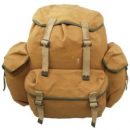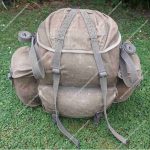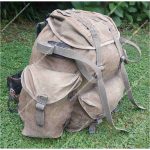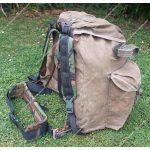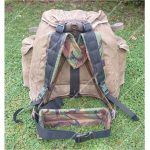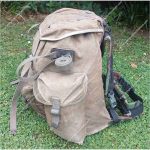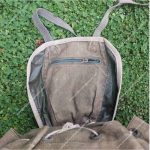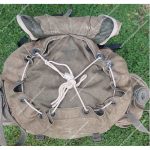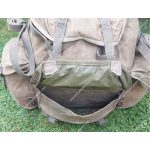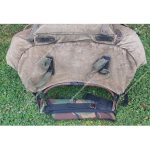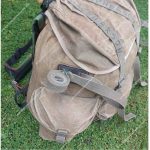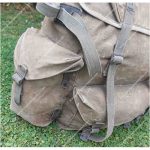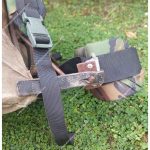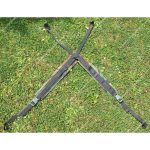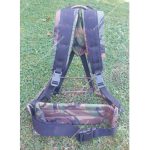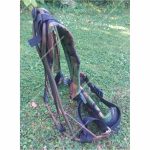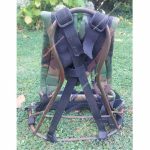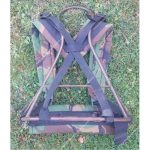Rucksack (Bergen)
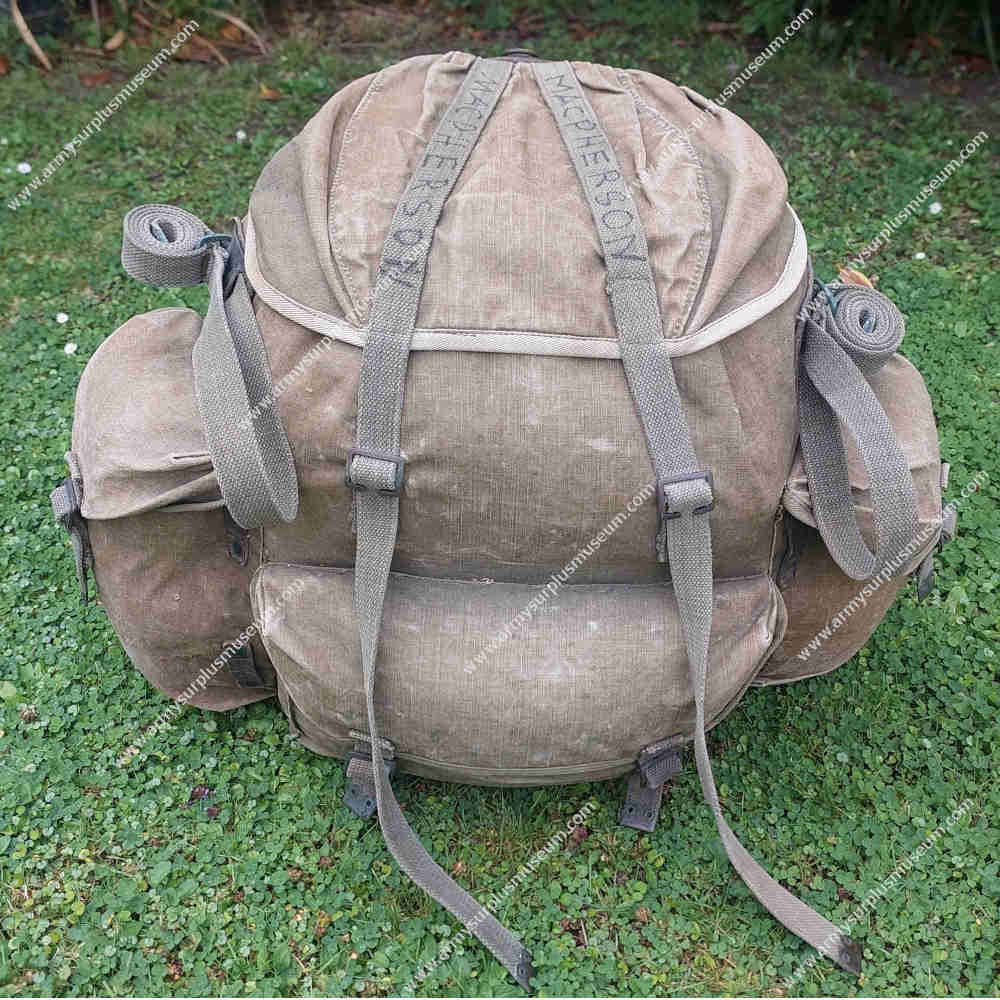
General Information
Name: Rucksack (Bergen).
Country of Origin: The United Kingdom.
Manufacturer: Stamp is illegible.
Date of manufacture: C 1960.
Stores Number/ NATO Number: Stamp is illegible.
Colour: Olive Drab
Equipment Family: Not specified.
Number Of compartments: Six.
Frame: External “A” Type frame.
Volume Capacity: 75L.
Flat map pocket-1L.
Main Compartment- 60L.
Front pocket- 6L
Side pockets- 4L each.
Weight: 3.2kg.
Waterproof: Depends on the issue.
Similar Objects
History
The 42-Pattern Rucksack, commonly known as the Bergen, originated in 1942 with the goal of providing specialist troops the capacity to carry larger and heavier loads, facilitating extended field operations without frequent resupply. Developed in collaboration with the Norwegian outdoor company Bergens, it earned its name “Bergen Rucksack,” later shortened to simply “Bergen,” which persists as the term used by British soldiers for any large rucksack to this day.
Drawing inspiration from two 1930s Bergens of Norway, the design underwent modification with input from the British army to create a versatile rucksack suitable for various units. The frame design positioned the load lower on the back for stability during skiing and efficient weight distribution. Fabricated with heavy canvas cloth, the rucksack’s design prioritized easy access to essential items and allowed for the external carriage of items like skis and snowshoes.
Initially issued to British Commandos in the early stages of World War Two, it later found use with the Parachute Regiment (Para’s) and Royal Marines Commandos. It became standard issue for numerous specialist units, including the Special Air Service (SAS) and Long Range Desert Group (LRDG), seeing action in diverse environments such as the jungle, arctic, and desert. During Operation Overlord (D-Day), British and Canadian soldiers utilized the rucksack for carrying sufficient ammunition and supplies until the arrival of the main force.
During the war, the rucksack surged in popularity and served as a model for emulation by Commonwealth forces. Both Canada and New Zealand developed their own versions, adopting and adapting the successful design. Additionally, the United States Army drew inspiration from the rucksack, using its design as a foundation for the M-41 Mountain Rucksack for the 10th Mountain Division specializing in mountain warfare.
Continuing post-World War Two, the rucksack served in conflicts like the Korean War, Malaya, Aden, Northern Ireland, and the Vietnam War with the New Zealand and Australian SAS. Its design evolved in the early 1960s, becoming more waterproof and transitioning to olive drab canvas cloth. By the late 1960s, the British army deemed the rucksack obsolete, leading to trials and production of a new design in the early 1970s—the SAS/Para Rucksack. Despite the transition, the original rucksack remained available in the surplus market, favored by those who preferred it or sought a vintage aesthetic.
Description
The Rucksack features a fixed permeability lid that closes securely with two long webbing straps and metal 37-pattern type buckles. These straps are sewn down in an X style across the length of the lid, leaving no room for items to slip through. To enhance security, the underside of the lid includes a full-length flat pocket closed with a small metal zip at the front edge.
For the main compartment, its mouth is drawn in over the contents using a cotton draw-cord covered by a cotton cover. Inside, a large, flat open-top pouch allows quick access to essential items. The Rucksack also includes spacious side pouches closed with webbing straps and metal buckles, featuring lids designed to extend down the sides when closed.
The front pouch, a large square pocket, is sealed with two webbing straps and metal buckles, and the mouth is further secured with a metal zip. Above the side pouches are very long webbing straps for securing external items like a rolled-up sleeping bag. These side pouches run most of the Rucksack’s length and close with a webbing strap and metal buckle. The trailing edge of the side pouches includes two vertical leather loops to further secure items externally like skis and snowshoes.
Moving to the back, the Rucksack features a leather envelope where the top of the frame is inserted, along with a small metal D-ring above it. The bottom is reinforced with a leather strap protecting it from the frame. Short leather tabs secure the bottom of the Rucksack to the sides of the frame. The base of the Rucksack has two very long webbing straps for securing additional items externally.
The shoulder straps, made of woven cotton webbing, are permanently attached to the bottom of the frame via support straps sewn to more conventionally sized shoulder straps at the top. Short leather straps at the top secure the frame to the Rucksack by threading through openings in the leather envelope. Further down the shoulder straps, short, wide webbing straps allow a pair of 37-Pattern Utility Pouches to be fitted.
The frame, crafted from solid steel tubing shaped into an “A” shape, has a small rounded top and wide bottom. The lumbar strap is permanently fixed to the sides of the frame with metal rivets, though this was changed in later versions, and each side now has a metal boss to which the Rucksack’s short leather tabs attach.
Examples
Example One
The Bergen underwent a design change in the mid-1960s, transitioning to a construction of green cotton canvas and incorporating waterproofing using a green rubberized fabric in specific areas. The rubberized fabric extends to the underside of the lid and the front and sides of the pouch, eliminating the zip on the front pouch’s mouth. Notably, D-rings on the sides of the frame were added to accommodate a lumber strap in a more conventional format.
The shoulder straps of this particular Bergen, originally utilized by a New Zealand soldier, have undergone customization. The original straps were replaced with a contemporary design tailored for this version. Crafted from black nylon webbing, these straps feature a waterproof DPM Entrant nylon cloth, reminiscent of the material used in New Zealand army waterproofs from the early 1990s.
These shoulder straps are padded, forming an X shape and equipped with closed-cell foam padding for enhanced comfort. The back straps are threaded through the bottom of the frame and the envelope of the Rucksack, securing firmly at the shoulders. Similarly, the front straps are looped to the frame and securely clipped to side-release buckles positioned on the front of the shoulder straps. The lumbar pad, also padded with closed-cell foam, takes inspiration from the lumbar pad design found in early New Zealand army Alice packs.
Name: Rucksack, 60-Pattern.

